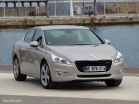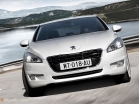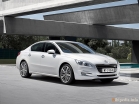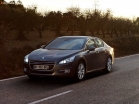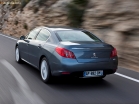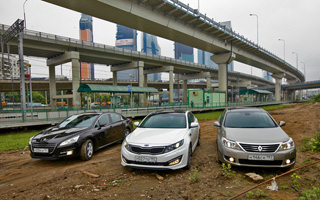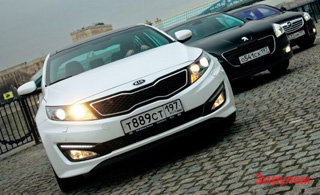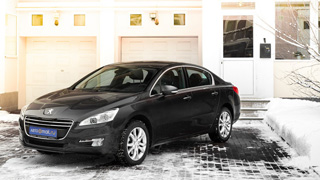PEUGEOT 508 Sedan test drive since 2010 sedan
Peugeot 508. Flushing, but growing
 Flatter, but growing. The new Peugeot 508, in fact, replaced two models playing in the D-class 407th and business sedan 607. Both have already been removed from production. Competitors rode away significantly forward, it is necessary to know the honor of the French. We flicker because the role of the flagship is now over the 508th, and it belongs to the D-segment, for a minute. Why are we growing? Because the five hundred eighth is much longer than its predecessor, in addition, it gained a lot of innovative systems.
Flatter, but growing. The new Peugeot 508, in fact, replaced two models playing in the D-class 407th and business sedan 607. Both have already been removed from production. Competitors rode away significantly forward, it is necessary to know the honor of the French. We flicker because the role of the flagship is now over the 508th, and it belongs to the D-segment, for a minute. Why are we growing? Because the five hundred eighth is much longer than its predecessor, in addition, it gained a lot of innovative systems. The 508th stretched platform 3 from the 407th, developed by the PSA Peugeot Citroen. Compared to the predecessor, the base of the 508th increased by 9.2 cm, which allowed to play a little more than five centimeters in the longitudinal direction. So the 508th boasts with almost the same amount of space as the 607th!
If the 407th were simply increased to the size of the 508th, then it would have been hung by about 50 kilograms. But the growing newcomer, on the contrary, lost weight. 508-sean is easier than a similar predecessor for 25 kg, and the SW station wagon at 45. The engineers tried well. Revised the variety of steels used in the power structure. The hood, for example, is an aluminum, cross -member under the dashboard in the front of the power cell from magnesium. Several kilograms were played on more light noise -absorbing materials. The universals have a lid of the trunk, the composite external panel is made of plastic ... By the way, this is the first case when Peugeot takes in orbit a model in two bodies at once. Previously, the French modifications into production were gradually displayed with decent time intervals.
The geometric patency of the 508th has become a little better. The notorious front overhang was shortened by 4.3 cm compared to Peugeot 407. True, the rear bumper became longer, this made it possible to significantly increase the volume of the trunk and improve the stylistic balance. The car has become more proportional. But how memorable was the appearance? No matter how much I was looking for in the five hundred eighth lion's breed, I did not find. She is simply not in him!
Six two two gasoline, four diesel, power from 112 to 204 hp. I managed to try two powerful versions with a gasoline 156-horsepower 1.6 with turbocharged and a 204-horsepower 2.2-liter turbodiesel.
1.6 was created jointly with the BMW concern, this is the generation of the same sensational unit that caused and causes complaints to 207 RC and modifications of the 308th model. Oddly enough, it is placed BMW on Mini, but there are not many complaints about the motors on these cars. Either in the settings is a matter, or in components from different suppliers, although Peugeot recently fixed the problem, because of which the control electronics turned off the turbine. I hope the troubles of the 508th model will not touch. But the motor is not bad. And the moment (240 nm at 4000 rpm) he has enough, and everything is in order with efficiency. The passport is average for a hundred 6.5 liters, and this is when accelerating to 100 km/h in 8.6 seconds. In fact, about 10 liters came out in the mixed cycle in the suburbs of Spanish Alikant. We must pay tribute to the road complex: the pagan serpentines with steep lifts/descents, accelerations in ringing and braking were interspersed with autobahns and small town ... direct injection, a great business. I went on a sedan with mechanics, the version with a robotic six -speed automatic consumption is slightly higher.
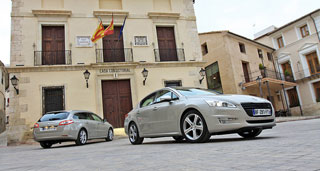 204-horsepower flagship turbodiesel 2.2 HDI True Frenchman. He replaced the 2.7-liter diesel six. The engine received a turbine with a minor impeller and a guide device with a variable geometry. There is an anti -tower filter, a recirculation system for exhaust gases and balancer shafts. Despite the latter, trembling at idle on the body still runs out. The low-speed motor, the maximum torque of 450 nm is reached at 2000-2750 rpm, peak 204 forces develop at 3,500 revolutions. With this motor, the car more dynamically shoots up to hundreds in 8.2 seconds, the station wagon in 8.8! Economics with such traction is good, but the transmission is short. It is good that with this engine there is only a six -speed Aisin hydrotransformer machine, with a mechanical box you could be tortured. The automatic transmission shoots short steps smoothly, and it works quite adequately to the decrease, although you can quickly think manual control of the automaton during an intense drive of advantages. The box responds to the commands slower than you expect from the manual regime.
204-horsepower flagship turbodiesel 2.2 HDI True Frenchman. He replaced the 2.7-liter diesel six. The engine received a turbine with a minor impeller and a guide device with a variable geometry. There is an anti -tower filter, a recirculation system for exhaust gases and balancer shafts. Despite the latter, trembling at idle on the body still runs out. The low-speed motor, the maximum torque of 450 nm is reached at 2000-2750 rpm, peak 204 forces develop at 3,500 revolutions. With this motor, the car more dynamically shoots up to hundreds in 8.2 seconds, the station wagon in 8.8! Economics with such traction is good, but the transmission is short. It is good that with this engine there is only a six -speed Aisin hydrotransformer machine, with a mechanical box you could be tortured. The automatic transmission shoots short steps smoothly, and it works quite adequately to the decrease, although you can quickly think manual control of the automaton during an intense drive of advantages. The box responds to the commands slower than you expect from the manual regime. The greatest technical interest among the rest is the version of 1.6 E-HDI. True, she failed to try in the case. It develops a turbodiesel of 112 forces and 270 Nm (short -term in Overboost 285 Nm) torque, and it is combined with a six -speed robotic box. The power unit operates under the start of the Start/Stop system. Interestingly, it saves up to 15% of the fuel in the city cycle.
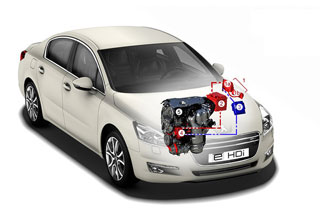
Components version 1.6 E-HDI equipped with Start/Stop:
1 e-booster
1a block of power electronics
1B block 5-volt supercondensers for engine start
2 12-volt battery
3 control unit
4 generator
5 112-horsepower turbodiesel 1.6 e-hdi
If Electronics understands that you intend to stop, it dramatizes the engine at a speed of 8 km/h. It is worth stomping on the gas pedal, the motor will come to life right there. But in the urban crowd and traffic jams, the engine is not launched by the battery, but by 5-volt supercondensers. They reduce the load on the main battery (it provides the operation of all consumers on board with an unemployed engine), retain its resource and expand the temperature range of the Start/Stop system. Charging capacitors, however, like charging the main 12-volt battery (70 ACh), is carried out mainly when the crankshaft revolutions are reduced, this saves fuel due to the fact that the generator during the increase in the rotation of the crankshaft, in fact, does not work and does not work and does not work and does not work Does not take the power.

In the arsenal of Peugeot 508, six airbags. To moderately, a strict rational system can be turned off only at speeds up to 50 km/h.
Two MacPherson (left below) and on parallel A-shaped transverse levers (installed on the GT version)
PEUGEOT 508 received two types of front suspension. The flagship version of GT with a 2.2-liter 204 strong diesel stands on a bridge with double transverse levers, like the 407th model. All other modifications received cheaper MacPherson. This scheme has migrated from the Citroen C5 noise. Modifications behave completely differently. GT has more mature habits. It is a little tougher, and the course holds more reliable. The steering wheel is somewhat lighter and cleaner, information content is higher, while the background force of feedback on the arc is more pleasant. Moderate rolls there, and there. What is not Passat? Such a gloss is a merit of not only parallel levers, the characteristics of the elastic and damping elements of GT others, and the electric power is configured differently. At the back of all versions, a multi -link, collected on a spatial subframe. Five hundred eighth is not afraid of broken asphalt.
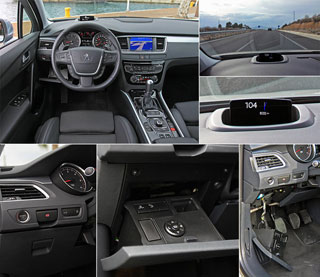
Kokpit is good. Ergonomics and appearance of five points. The glass projection display, when the ignition is turned on, automatically leaves the front panel under the action of the electric drive. The angle of its inclination is also regulated by electric drive. Glare on the windshield from the display frame in sunny weather interfere with the view
Inside 508 is older and more noble than its predecessor. Soft plastic, pleasant smell. Optional four -zone climate. The side mirrors are larger, planting is more convenient than in the four hundred and seventh. It is possible to order an option with chairs that have a pillow adjustment in length and a lumbar massage. Behind the place of the wagon, but I, having 190 cm in height, would like to have a greater supply above my head. By the way, there is roughness in terms of acoustics. The status in some operating modes of the engine is not heard, with increased revolutions of the motor, its overtones also penetrate the salon. About 80 km/h, the noise of the mirrors crawls.
There are no complaints about the combination of devices in moderation strictly, pleasant, informative, nothing more. From the bikes of the retractable projection screen, installed on the visor of the dashboard under the windshield. The thing, I must say, is strange on it duplicate the readings of the speedometer, cruise control and the icon of the navigation system. Why not immediately on the windshield?! The adjustment of the angle of the screen of the screen compensates for the height of the landing, the regulation is carried out by a joystick located on a retractable console, which to the left of the steering column. By the way, I tore this console, along with the joystick, accidentally confusing her pen with a touch of the electromechanical handbrake like a touch. Hands to blame! He tore off, but immediately advocated his place.

Everything that is called is in their places ... except for leaving cup holders located under a multimedia display. Glasses or banks with drinks overlap part of the display. On the bottom right control unit of a separate climate of the back row
PEUGEOT 508 received a multimedia system with a new navigation, AUX-sharing for audio sources and a USB port, through which you can connect the iPod and iPhone. Menomanias are addressed to a six-channel 500-watt JBL audio system with a subwoofer. And Wi-Fi can also be available, which provides simultaneous access to the wireless Internet for several passengers, and a 230-volume outlet. In general, the car turned out to be more than adult.
From means that increase safety and comfort, a system of automatic shift of high beam to the near and vice versa. Switching to the neighbor will occur when oncoming and passing vehicles appear in front of the car. There are also headlights and fog -tanks looking into the turn, they work in different speed ranges (turning headlights at high speeds, foglights highlight turns at low ones). Diode daylight lights are diode here. All versions of 508 are equipped with a helping system when touching on a slope, it holds a car of the parkingum for a couple of seconds before starting, using a side sonar built into the front bumper, is able to independently determine whether you have enough space for the car, which were parked in parallel to the border, the main thing is not to move faster 20 km/h. Interestingly, will Peegeot soon have automatic parking systems? Some competitors already have them.
The industrial launch of the sedan at the French factory in Renna, took place in the month of October, now there is a setup of the station wagon, which will go to dealers in the summer. China after Europe is the second most important market. There, the production of the 508th model will also soon be launched, however, only sedans will be released in the Middle Kingdom. In Russia, the novelty will appear in the fall, and at the Kaluga factory, 308 and 4007 will still remain at the conveyor. The cost of the sedan, which has been sold in Europe from the beginning of February, starts from the mark of 23,000 euros. The highest bar is 35,000 euros. Five hundred eighth on average for a couple of thousand cheaper than similar versions of the same Volkswagen Passat. Rivalry promises to be interesting, given that competitors in the D-class with a dozen and a half.
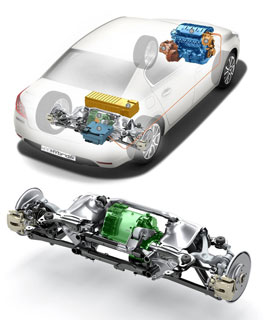
In the future, Peugeot plans to issue a hybrid 508 with a Hybrid4 drive. The car is planned to make all -wheel drive. The front wheels will rotate the internal combustion engine, the rear motor-generator.
Hybrid4 drive components:
1 motor-generator leading rear wheels
2 traction battery
3 Block of power control electronics
4 starter
5 -speed robotic gearbox
6 turbodiesel 2.0 hdi, leading front wheels
7 specially prepared multi -link suspension
Vitaly Kabyshev
Photo: Vitaly Kabyshev and Peugeot
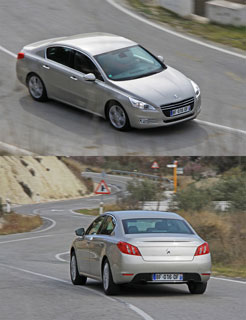




Alternative
Among the middle class models (its second name segment D), which include Peugeot 508, today there is a frantic competition, and therefore there are plenty of rivals. We selected the most popular cars among Russians from 4,500 to 4900 mm long and a width of 1700 to 1800 mm.
Volkswagen Passat from 789 thousand rubles
Sedan from 789 thousand rubles to 1 million 409 thousand rubles; Universal from 880 thousand rubles to 1 million 273 thousand rubles.
Modifications: 1.6 (102 hp) MT, 1.4 TSI (122 hp) dsg, 1.4 TSI (122 hp) MT, 1.8 TSI (152 hp) dsg, 1.8 tsi (152 l . S.) MT, 2.0 FSI (150 hp) 4Motion MT, 2.0 TDI (140 hp) DSG, 2.0 TDI (140 hp) MT, 2.0 TSI (200 hp) AT .
2 years warranty without mileage restriction
Mazda6 from 739 thousand rubles
Sedan from 739 thousand rubles to 1 million 158 thousand rubles; Hatchback from 811 thousand rubles to 1 million 176 thousand rubles.
Modifications: 1.8 (120 hp) mt, 2.0 (147 hp) at, 2.0 (147 hp) mt, 2.5 (170 hp) at, 2.5 (170 hp) MT.
Warranty 3 years or 100,000 km of run
Toyota Avensis from 879 thousand rubles
Sedan from 879 thousand rubles to 1 million 379 thousand rubles; Universal from 949 thousand rubles to 1 million 474 thousand rubles.
Modifications: 1.8 (147 hp) cvt, 1.8 (147 hp) MT, 2.0 (152 hp) CVT.
Warranty 3 years or 100,000 km of run
Honda Accord from 985 thousand 300 rubles
Sedan from 985 thousand 300 rubles to 1 million 215 thousand 400 rubles.
Modifications: 2.0 (156 hp) at, 2.0 (156 hp) MT, 2.4 (201 l.S.) AT, 2.4 (201 l.S.) MT.
Warranty 3 years or 100,000 km of run
Chevrolet Epica from 657 thousand 900 rubles
Sedan from 657 thousand 900 rubles to 848 thousand 900 rubles.
Modifications: 2.0 (143 hp) at, 2.0 (143 hp) MT.
2 years warranty without mileage restriction
Hyundai New Sonata from 899 thousand 900 rubles
Sedan from 899 thousand 900 rubles to 1 million 208 thousand 900 rubles.
Modifications: 2.0 (150 hp) at, 2.0 (150 hp) MT, 2.4 (178 hp) at.
Warranty 3 years or 100,000 km of run
Opel Insignia from 837 thousand 300 rubles
Sedan from 837 thousand 300 rubles to 1 million 526 thousand 800 rubles; hatchback from 837 thousand 300 rubles to 1 million 526 thousand 800 rubles; Universal from 882 thousand 300 rubles to 1 million 571 thousand 800 rubles.
Modifications: 1.6 (115 hp) MT, 1.8 MT (140 hp), 1.6t (180 hp) MT, 2.0 dt (130 hp) AT, 2.0 dt (130 p. p.) MT, 2.0 DTH (160 hp) AT, 2.0T (220 hp) AT, 2.0T (220 hp) MT, 2.0t (220 hp) 4x4 AT, 2.0t (220 hp) 4x4 MT, 2.8T (260 hp) 4x4 AT, 2.8T (260 hp) 4x4 MT. In 2009, 832 cars were sold.
2 years warranty without mileage restriction
Ford Mondeo from 699 thousand rubles
Hatchback from 963 thousand rubles to 1 million 113 thousand 500 rubles; sedan from 699 thousand rubles to 1 million 138 thousand 500 rubles; Universal from 978 thousand rubles to 1 million 247 thousand rubles.
Modifications: 1.6 (120 hp) MT, 2.0 (140 hp) AT, 2.0 (145 hp) MT, 2.0 (200 hp) AT, 2.0 (240 hp) AT, 2.3 (160 hp) AT.
Warranty 3 years or 100,000 km of run
Skoda Superb
Hatchback from 899 thousand rubles to 1 million 154 thousand rubles; Universal from 1 million 349 thousand rubles.
Modifications: 1.8 TSI (152 hp) DSG, 1.8 TSI (152 hp) MT, 2.0 TDI (140 hp) DSG, 2.0 TSI (200 hp) AT.
2 years warranty without mileage restriction
Renault Latitude
Sedan from 835 thousand rubles to 1 million 225 thousand rubles.
Modifications: 2.0 (139 hp) cvt, 2.5 (177 hp) at.
Warranty 3 years or 100,000 km of run
Nissan Teana
Sedan from 969 thousand rubles to 1 million 391 thousand rubles.
Modifications: 2.5 (167 hp) 4WD CVT, 2.5 (182 hp) at, 3.5 (249 hp) at.
Warranty 3 years or 100,000 km of run
Suzuki Kizashi
Sedan from 995 thousand rubles to 1 million 279 thousand rubles.
Modifications: 2.4 (178 hp) 2WD MT, 2.4 (178 hp) 2WD at, 2.4 (178 hp) 4wd at.
Warranty 3 years or 100,000 km of run
Competitors Alexei Kovanov
Source: Auto.mail.ru
Video test drives Peugeot 508 sedan since 2010
Video Crash tests Peugeot 508 sedan since 2010
PEUGEOT 508 Sedan tests since 2010
PEUGEOT 508 Crash test since 2010
Krassh Test: Detailed Information90%
Driver and passengers
41%
Pedestrians
87%
Children-passengers
97%
Active security system

